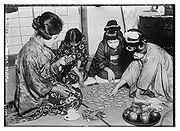
Uta-garuta
Encyclopedia

Karuta
is a Japanese card game.The basic idea of any karuta game is to be able to quickly determine which card out of an array of cards is required and then to grab the card before it is grabbed by an opponent. There are various types of cards which can be used to play karuta...
, Japanese traditional playing cards. It is also the name of the game in which they are used. The game is played mostly on Japanese New Year
Japanese New Year
The is one of the most important annual festivals, with its own unique customs, and has been celebrated for centuries. Due to the importance of the holiday and the preparations required, the preceding days are quite busy, particularly the day before, known as Ōmisoka.The Japanese New Year has been...
's holidays. On each card, a poem (waka
Waka (poetry)
Waka or Yamato uta is a genre of classical Japanese verse and one of the major genres of Japanese literature...
) is written, and there are a total of 100 poems. The standard collection of the poems used is called Hyakunin Isshu
Hyakunin Isshu
is a traditional anthology style of compiling Japanese waka poetry where each contributor writes one poem for the anthology. Literally, it translates to "one hundred people, one poem [each]"...
, which is often also the name of the game. The collection was chosen by a poet Fujiwara no Teika
Fujiwara no Teika
Fujiwara no Teika , also known as Fujiwara no Sadaie or Sada-ie, was a Japanese poet, critic, calligrapher, novelist, anthologist, scribe, and scholar of the late Heian and early Kamakura periods...
in Heian period
Heian period
The is the last division of classical Japanese history, running from 794 to 1185. The period is named after the capital city of Heian-kyō, or modern Kyōto. It is the period in Japanese history when Buddhism, Taoism and other Chinese influences were at their height...
. There are national conventions for the game.
Basic rule
The game uses two types of cards.- Yomifuda: One hundred reading cards with a figure of a person, their name and poem on each one
- Torifuda: One hundred grabbing cards with only the lower phrases of poems
At the start of a game, all the 100 torifuda are neatly arranged on the floor faced up. When the reader starts reading out a poem on the yomifuda, the players quickly search for the torifuda on which the corresponding lower phrase is written.
There are two ways to play the game based on the rule above.
Chirashi-dori
One reader, more than three players:- Mix up the deck of torifuda, and lay them out on the floor. Players sit around the cards.
- The reader starts reading out the waka, and players take corresponding torifuda as fast as possible. They can do it immediately when they already know the lower phrase.
- When a torifuda was taken, the reader moves on to the next waka.
- When all the cards are taken, the player with the most cards wins the game.
Genpei-gassen
One reader, players on two sides:- Divide the players into two groups. One is called the Genji side and the other the Heike side.
- Mix up the torifuda, and give 50 cards to each side.
- Genji and Heike sit face to face. Lay out 50 cards in front of each group in three lines to face the group.
- The way to take the torifuda is the same as with Chirashi-dori.
- Players can take cards on both sides.
- When they took cards on the opponent side, they can move one card to the side of the opponent.
- If they take a wrong card, the opponent can move a card from their side.
- The side that takes all the torifuda on their side wins the game.
The odds of winning increase if one knows the phrases. One even may be able to take the cards immediately after hearing the reader read aloud only the first letters of the waka.

